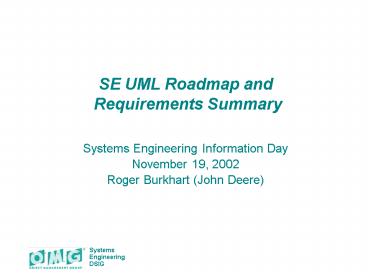SE UML Roadmap and Requirements Summary - PowerPoint PPT Presentation
1 / 19
Title:
SE UML Roadmap and Requirements Summary
Description:
Roger Burkhart (John Deere) Requirements Summary and Roadmap. November 19, 2002. 2. Systems ... Outline the process expected to unfold over the next ... – PowerPoint PPT presentation
Number of Views:50
Avg rating:3.0/5.0
Title: SE UML Roadmap and Requirements Summary
1
SE UML Roadmap and Requirements Summary
- Systems Engineering Information Day
- November 19, 2002
- Roger Burkhart (John Deere)
2
Goals for Presentation
- Outline the process expected to unfold over the
next12-16 months to define a UML-based language
for Systems Engineering - Summarize the requirements that submitters to a
Request For Proposal (RFP) for a UML-based
language for Systems Engineering will be asked to
satisfy
3
RFP Process for SE UML
- Systems Engineering Domain Special Interest Group
(SE DSIG) drafts RFP - Analysis Design Platform Task Force votes to
issue RFP - Submitters respond with initial revised
submissions according to submission schedule - SE DSIG and ADTF evaluate RFP and vote on
adoption - Architecture Board and Platform Technical
Committee (PTC) also review and vote
4
The Road So Far (Key Milestones)
RFI Responses, Review of SE Reqts, SE Prototype
and SE Conceptual Model (Orlando)
Start of RFP Drafting and Continued Review of
Inputs (Washington)
5
The Road to SE UML
Draft RFP for Review (Burlingame)
Review Draft RFP at INCOSE Intl Workshop (Tampa)
Vote to Issue RFP (Orlando)
Possible Earliest UML 2.0 Adoptions(Orlando)
AP-233 Structures Module Set in Alpha Release
AP-233 Second Two Behavioral Module Sets in Alpha
Release
AP-233 First Two Behavioral Module Sets in Alpha
Release
AP-233 Text- and Property-based Reqts in
Beta/Alpha Release
6
The Road to SE UML
Initial Submissions Due(January Meeting)
Revised Submissions Due(March Meeting)
Submission Presentations and Evaluation(January-J
une Meetings)
Possible Vote to Adopt(June Meeting)
7
RFP Outline
- Objective (Cover Page)
- Introduction
- Architectural Context
- Adoption Process
- Instructions for Submitters
- General Requirements on Proposals
- Specific Requirements on Proposals
- Appendix A References and Glossary
8
6. Specific Requirements on Proposals
- 6.1 Problem Statement
- 6.2 Scope of Proposals Sought
- 6.3 Relationship to Existing OMG
Specifications - 6.4 Related Activities, Documents and
Standards - 6.5 Mandatory Requirements
- 6.6 Optional Requirements
- 6.7 Issues to be discussed
- 6.8 Evaluation Criteria
- 6.9 Other information unique to this RFP
- 6.10 RFP Timetable
9
Requirements Analysis
- SE UML Requirements Analysis V0.4, Nov. 2002
- Key Sources
- RFI responses
- SE Conceptual Model
- SE Prototype
- UML 2.0 Submitter Interaction
- Related OMG specifications (e.g. Real-Time
Profile) - Related Papers, etc.
- Basis for initial draft of RFP requirements
10
SE UML Requirements Analysis
AP-233, OMG INCOSE Inputs
SE UML Profile RFP
SE Reqts Analysis
Other sources
SE Conceptual Model
UML V2.0 Input
SE UML Prototyping Evaluation
Issues Approaches
UML Meta-Model Profiles
SE UML RFI
Industry Responses
11
RFI Responders
- Artisan
- BAE Systems (CNI Division)
- Georgia Tech
- Holistic Systems Engineering
- I-Logix
- INCOSE OOSEM Working Group
- Lockheed Martin Corporation
- Mitre
- Project Technology
- Rational Software
- Systems Engineering Consulting
- Tofs AB
- Volvo Car Corporation
12
Evaluation Criteria for SE UML
- Ease of use
- Unambiguous
- Precise
- Complete
- Scalable
- Adaptable to different domains
- Integration with other modeling languages
- Process and method independence
- Compliance with UML meta-model
- Verification of proposed solution
13
Current Requirements Categories
- Structure
- Behavior
- Properties
- Requirements
- Verification
- Other
14
1. Structure
- Hierarchy of systems and subsystems
- Interconnection of system components
- Boundary of system and environment
- Cross-cutting of functional subsystems
- Varieties of composition for parts of system
- Deployment onto distributed resources
- Linkage to geometry and other domain-specific
models
15
2. Behavior
- Functional transformation of inputs to outputs
- Function activation/deactivation
- Control operators
- State (or mode) based behaviors
- Failure and other special states
- Composite functions and inputs/outputs
- Assignment of behavior to systems and components
- Input/output flows across system boundary
16
3. Properties
- Continuous- or discrete-valued properties
- Time-varying values and time rates of change
- Time clock as global value that can be referenced
whereever needed - Stochastic properties (defined by probability
distribution) - Measures of Effectiveness (MOE)
- Parametric relationships
- Parameter values expressed as functionsof other
parameters - Assignment of properties to all elements of
system including components and input/output
connections
17
4. Requirements
- Traceability from sources to stated requirements
- Allocation from requirements to model elements
responsible for satisfying them - Variety of requirements types
- Functional (what a system does)
- Non-functional (qualities or measures a system is
to possess) - Text- or property-based
- Weighting and risk
18
5. Verification and Validation
- Verification how a system or component complies
with its requirements - Validation how a system or component requirement
complies with stakeholder needs
19
6. Other
- General relationships, e.g. Collection,
Composition, Instantiation, Model Views - Decision Trees
- Family of Languages
- Executable Models
- Glossary Harmonization
- Life Cycle Considerations
- Symbology































